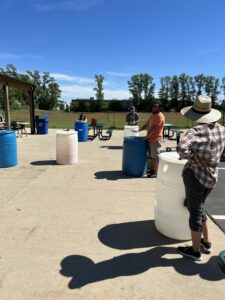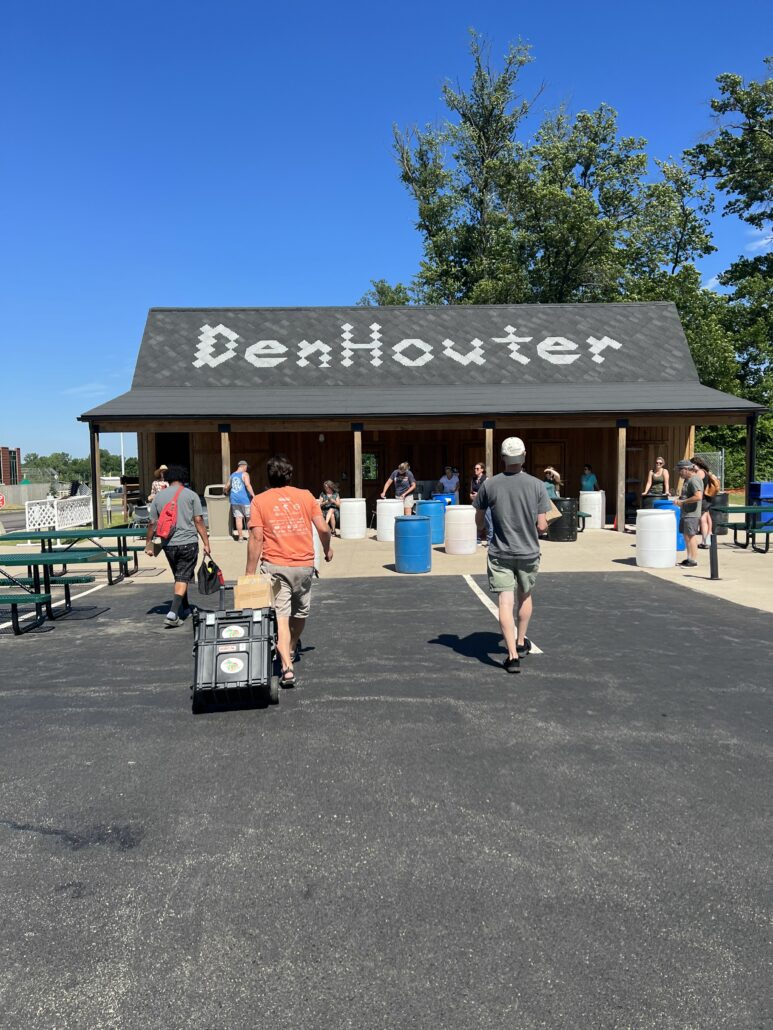By Juan Pablo Angel Marcos, WMEAC Eco-Journalism & Blogging Intern
If you are curious about how you can help improve water quality within your community, implementing a rain barrel for your home can be an easy and effective way to do so.
The overall goal of rain barrels is to manage stormwater runoff and nonpoint source pollution by collecting it in one place. This prevents the water from flowing from your roof to surfaces like roads and driveways that move pollutants into storm drains and ultimately our local streams.
Throughout the spring and summer months, WMEAC has been carrying out Rain Barrel Workshops for residents of West Michigan, to educate individuals on green infrastructure practices, which is infrastructure that filters and absorbs stormwater where it naturally falls using plants and soil, or permeable pavement. During the workshop, individuals also learn about stormwater concerns like flooding, erosion in streams, and nonpoint source pollution from our neighborhoods.
A few weeks ago, I got to see firsthand just how simple these rain barrels are to construct, as I was able to attend a Rain Barrel Workshop held at the Mary Free Bed YMCA in Grand Rapids. There were about 13 participants that attended the event led by WMEAC’s staff members: Carlos Calderon and Kyle Hart.
During the event, participants constructed their personal rain barrels with simple tools like zip ties, wrenches, steel hose parts, and hand drills. Once the workshop was completed, participants were able to bring their own rain barrel home for immediate use.
For those who don’t know, a rain barrel is a container that collects stormwater from a downspout which is attached to a rain gutter on a home’s roof. The water that is collected can then be used for washing your car, watering your lawn and gardening, or anything you would use your hose for. It’s important to remember that the water should not be used for drinking as there can be debris, leaves, or bacteria within the water.
The most common use for collected rainwater is to water gardens and vegetables. It’s best practice to apply the water directly to the roots and to wash any fruit or vegetables properly before eating them. Rainwater for plants is more beneficial than tap water because it contains nitrogen, a nutrient essential for growth.

There is another thing to keep in mind. If you have recently installed a new roof on your home, you will need to wait at least three years before attaching a rain barrel to the downspout. New asphalt roofs for example, can shed particulates that could leach heavy metals into your rainwater that can harm plants and foods.
Storm drains, a type of gray infrastructure, do not filter out pollution through natural processes like soil infiltration. Instead, they carry water from our streets and sidewalks into local streams and can mobilize pollution like oil, salts, and other chemicals. Using the water from a rain barrel for watering your lawn or garden allows the water to be filtered through the soil like it was supposed to in a natural environment.
Ultimately, the use of rain barrels in your home allows you to make a difference in diverting stormwater into rivers and streams and preventing pollution from leaving our watersheds. You are also decreasing the dependence on your own personal water usage with something more sustainable. During peak summer months, you could be saving up to 1,300 gallons of water.
There are some general concerns people have when it comes to rain barrels. Some are mosquitos and algae. Mosquitoes can become a problem when you have standing water in your yard, however, putting a mesh screen over any opening in the barrel can prevent this issue, but if you want to get rid of them for good then you should hire a mosquito service.
Algae isn’t necessarily harmful, as it can provide more nutrients to plants, but it can be seen as negative due to its appearance or scent. Algae forms in the barrel if there is stagnant water and direct sunlight. It is best to dump standing water after 3-4 days to prevent algae or rinsing your barrel with a cup or two of vinegar. However, if you routinely use your rain barrel it will likely deter algae from growing as the water level will constantly be changing.
If you want your own rain barrel, WMEAC’s next workshop will be on August 27th at the Mary Free Bed YMCA from 9:00am – 10:30 am. You can get tickets for the workshop on WMEAC’s website.
If you are interested in constructing your own rain barrel at home, WMEAC has created a resource document detailing the assembly and installation process here.
Whether you already have a rain barrel or are interested in making your very first one, you can do your part to decrease your personal water usage and prevent water pollution in our streams. If you are interested in hosting a rain barrel workshop for your organization, please contact WMEAC’s Water Programs Manager: Carlos Calderon at ccalderon@wmeac.org.
Photo credit: Juan Pablo Angel Marcos, WMEAC

